Pendo vs Walkme: Which Is Better For New Client Onboarding
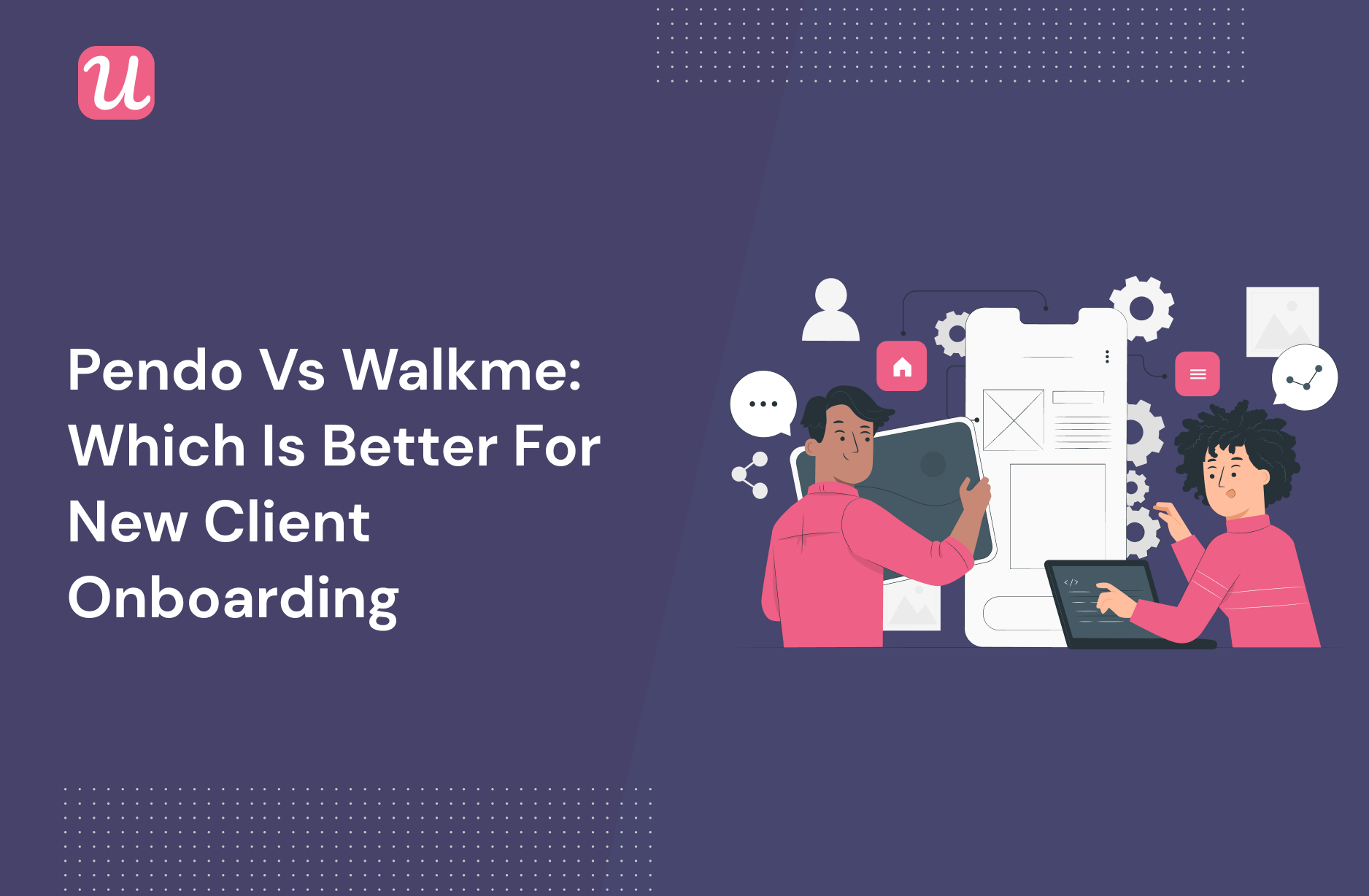
Is Pendo or Walkme the best tool for new client onboarding? And is there a better in-app onboarding software that would better fit your needs?
With so many alternatives on review sites, it’s a bit tricky to really choose one.
You have to consider your priorities and what functionality you’ll need from the tool to get the job done. Then the price should also match your budget. Right?
In this post, we’ll discuss exactly that – what the perfect tool for new client onboarding should deliver and which will be the best choice for your company’s needs.
Let’s dive in!
TL;DR
- A new client onboarding process involves introducing the company and product to the customer, answering questions, and guiding them through the process.
- In SaaS companies, onboarding is critical to retaining new customers.
- By using an onboarding tool, you will create a great first impression and ensure a smooth onboarding process for your users. You can create interactive walkthroughs for customers, personalize their journey based on segmentation, and send microsurveys to assess customer satisfaction.
- Pendo and Walkme are user onboarding tools that allow you to build product tours and interactive walkthroughs to onboard new customers.
- Though both are good tools in a SaaS market, they are not the right fit for everyone. For example, Pendo offers limited onboarding elements when creating onboarding flows. Apart from that, you can’t trigger flows based on in-app events.
- When it comes to Walkme, there is a steep learning curve and it’s designed for enterprise companies.
- Pendo and Walkme have a better alternative. Consider using Userpilot if you want to get the most out of your investment. This code-free tool allows you to create interactive and personalized onboarding experiences for new customers using a variety of UI patterns. Moreover, you will be able to use powerful segmentation and analytics features to better understand and serve your customers.
Looking for the best tool for new client onboarding? Search no more!

What is new client onboarding?
New client onboarding is a process that involves welcoming new clients, answering their questions, and ensuring they understand what your company offers. It’s usually delivered by Customer Success Managers for high-touch “white glove”client onboarding and may be automated for lower-ACV prosumer customers e.g. in SaaS.
Either way, it’s the time when your company establishes the relationship with your new client/customer, so it’s critical to get things right.
New clients might feel stressed about the onboarding time, wondering about the amount of time it will take them to truly understand and adopt your service/product, and feeling buyer’s remorse – whether they made the right choice and that you’re worth their time and money.
On the flip side, your customer success agents don’t know what the cooperation with the new client will be like, what are the client’s goals, and if it will be really possible to meet their expectations.
Let’s dive deeper into why new client onboarding is important, and how to get it right!
Why should you care about new client onboarding?
The new client onboarding phase is like the first date you may have with a new “romantic interest” – it’s a make-or-break few hours that determine if the next date is going to happen. Likewise, client onboarding may not last long, but it sets the stage for your whole relationship with that client.
Here’s why it’s so critical:
- The onboarding stage is a deciding factor for a lot of your clients whether to continue business with your company or not. According to Hubspot, 63% of customers consider the onboarding process when making a purchase.
- And no wonder – as the first interactions with your team, and whether there’s a lot of friction in the onboarding process or not – determine how your client perceives your company’s service level.
- Based on that, they would probably recommend your product/service to their friends or…not. So client onboarding also affects your Word of Mouth (WOM)
- This means that a bad client onboarding experience will likely leave you with poor reviews. And reviews on review sites like G2 or Capterra are an important deciding factor for most prospects considering your tool.
- Last but not least – the client onboarding phase affects the churn likelihood of your clients. If the goals are not set right in the onboarding phase, the expectations are not managed, and your client does not feel like they are reaching success – they will be more likely to feel disappointed in your product and churn.
Why do you need tools for new client onboarding?
Wondering why you even need a new client onboarding tool? There are several reasons why you may need one:
Let’s face it: you can’t provide a premium onboarding service to every client by hand, especially if you’re growing rapidly, and you’re selling to several client sectors.
And yet – considering what we discussed in the ‘importance of client onboarding’ – you really cannot afford to drop the ball on your ‘smaller’ users. So what can you do? To conduct new client onboarding well and reduce the friction for your new clients, you need the right onboarding tools
Here’s what the right new client onboarding tool that will allow you to do:
- Provide personalized onboarding flows that will be self-serve – will reduce the time your CSMs will need to spend with your clients explaining every feature of your product.
- Segment your users by company size, role, use case, and Job-to-be-done – to make sure you can deliver the right onboarding experiences to the right person, at the right time.
- Easily conduct surveys to understand your users’ goals, motivations, expectations, JTBDs, and desired outcomes.
- Track user journeys with simple user analytics and react to any problems as they arise.
- Provide self-serve support materials right inside your product, in a resource hub.
Your new client onboarding tools will allow you to do all the above synchronously, without having to deploy an army of CSMs on every single client.
Tool’s must-have features for new client onboarding?
Before picking your new client onboarding tool, you should check if it has most of the must-have features of a good onboarding tool:
Here’s what to look for before picking your client onboarding solution:
- Great segmentation capabilities – so you can segment your new clients by size, job to be done, role, use case, etc. – but also by in-app behavior.
- Ability to create no-code microsurveys – so you can easily collect additional information about your new clients that will help you customize their onboarding flows and experience.
- Features for creating no-code in-app experiences for onboarding: onboarding flows, checklists, tooltips, and modals.
- The option to create in-app resource centers for your new clients with multimedia content hubs – including help docs, knowledge base articles, video tutorials, as well onboarding flows. The knowledge hub should be available in-app and searchable by KWs.
- User analytics to monitor new client behavior inside your product, and catch customers that are failing to achieve their goals early – to offer them more personalized “human” support.
Pendo for new client onboarding
Pendo is a comprehensive digital adoption platform with impressive analytics, in-app feedback, and product adoption features
It caters primarily to enterprise users and probably has the most advanced analytics of all tools we’re covering in this article. But it all comes at a price.
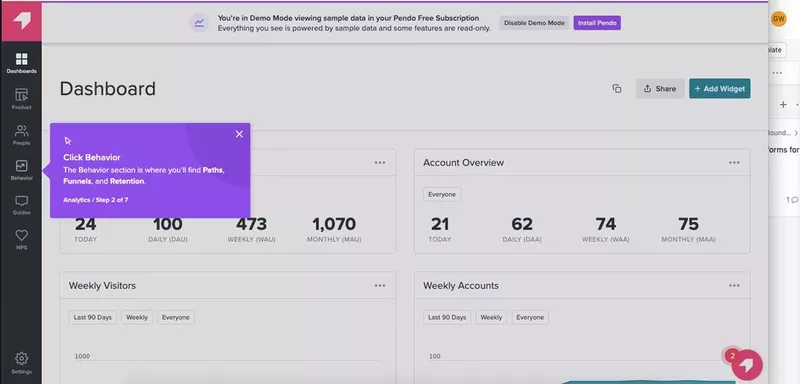
When it comes to user onboarding, Pendo offers guides for building in-app guidance that improves user onboarding across web and mobile apps. But how much do they cost, and are there better alternatives on the market?
Here’s what to expect from Pendo guides:
- You can build guides using templates, and there’s also a WYSIWYG (what-you-see-is-what-you-get) visual design studio editor for creating new designs from scratch.
- You can use Pendo’s free version to create user onboarding guides, but you’ll only get access to limited features and basic analytics.
- Types of guides you can create using Pendo include Lightbox, Banner, Tooltips, Polls, and Walkthroughs. The drawback with them is that they are quite basic and don’t allow much customization without coding. Even Pendo’s own onboarding guide is a series of purple tooltips.
- You can also build checklists with Pendo but not as standalone UI elements as users can only access them from the resource center (if they know they exit). This makes it hard and not intuitive for users to access guidance, and overall defeats the purpose of using checklists.
- Pendo product guidance for mobile works across Android and iOS mobile apps, so if you’re looking to support your mobile customers through their onboarding, Pendo might be for you (be aware that Pendo for mobile guides is not included on the free plan).
Guides or product tours are essential tools for user onboarding, and it will be difficult for new users to find their way around your app without them. The absence of these UX designs will lead to friction, naturally resulting in increased churn.
But do you need Pendo for this?
The answer is you don’t have to use Pendo in particular. There are other product adoption tools that give you more value for your money, so it’s always good to check the available options before settling for one.
Pros of Pendo?
Despite the price and its steep learning curve, Pendo does have a few pros compared to its competitors.
- Pendo is known for its good and easy-to-use analytics tools like Paths, Retention, and Funnels. (As of Q1 2023, Userpilot will have the same analytics features, with more robust functionality).
- Pendo has a shareable product-planning tool to organize customer feedback and prioritize high-value features. It helps keep teams aligned with the shared feature-planning guide.
- It works on web apps and mobile apps so if you need both, this might be a good choice for you.
Cons of Pendo?
Surprisingly for a product engagement tool that claims to be “all in one” you can’t act directly on the user analytics from Pendo in Pendo.
That’s because Pendo doesn’t allow you to target users segmented by in-app events with the in-app guides you’ve built with it.
Here’s a short list of Pendo’s cons:
- It doesn’t allow you to trigger experiences based on in-app events either. This is probably because of tech debt – but makes Pendo’s analytics pretty much NOT actionable.
- Pendo offers limited onboarding elements, which means you can’t always create the best experience for your users. If you want checklists these can only be accessed from the Resource Center which defeats the purpose of having them in the first place.
- Pendo’s pricing is only available to you if you ask for a quote. The company doesn’t list pricing on its site for the higher tiers. However, some reviews say they have prices starting at $20,000-$25,000 per year for a single product, and around $50,000 per year for the mid-tier package. This might be Pendo’s biggest downside.
If you’re looking for a tool that shows you user analytics in real-time and allows you to trigger in-app experiences based on in-app events and user behavior in real-time – Userpilot offers these features (and at a lower price tag too).
What users say about Pendo?
Users appreciate Pendo’s analytics but find it complex for building in-app guidance using the guides feature.
As soon as it has been integrated, Pendo is easy to use and manage without the need for developers. I also like that usage is captured retrospectively and the dashboard views or ability to segment users/accounts based on different criteria is really powerful. The guides are great and multi-functional making it really simple for Product Managers to help users navigate with walkthroughs, or post announcements or poll users; they allow Product Managers to get creative with how they engage and interact with users directly in the product. – Parita P.
The best feature about Pendo has been the constant collection of User clicks without the need to set up trackers via code. This enables us to tag the usage directly from the tool and start monitoring historic data without having to involve development teams.- Joseph E.
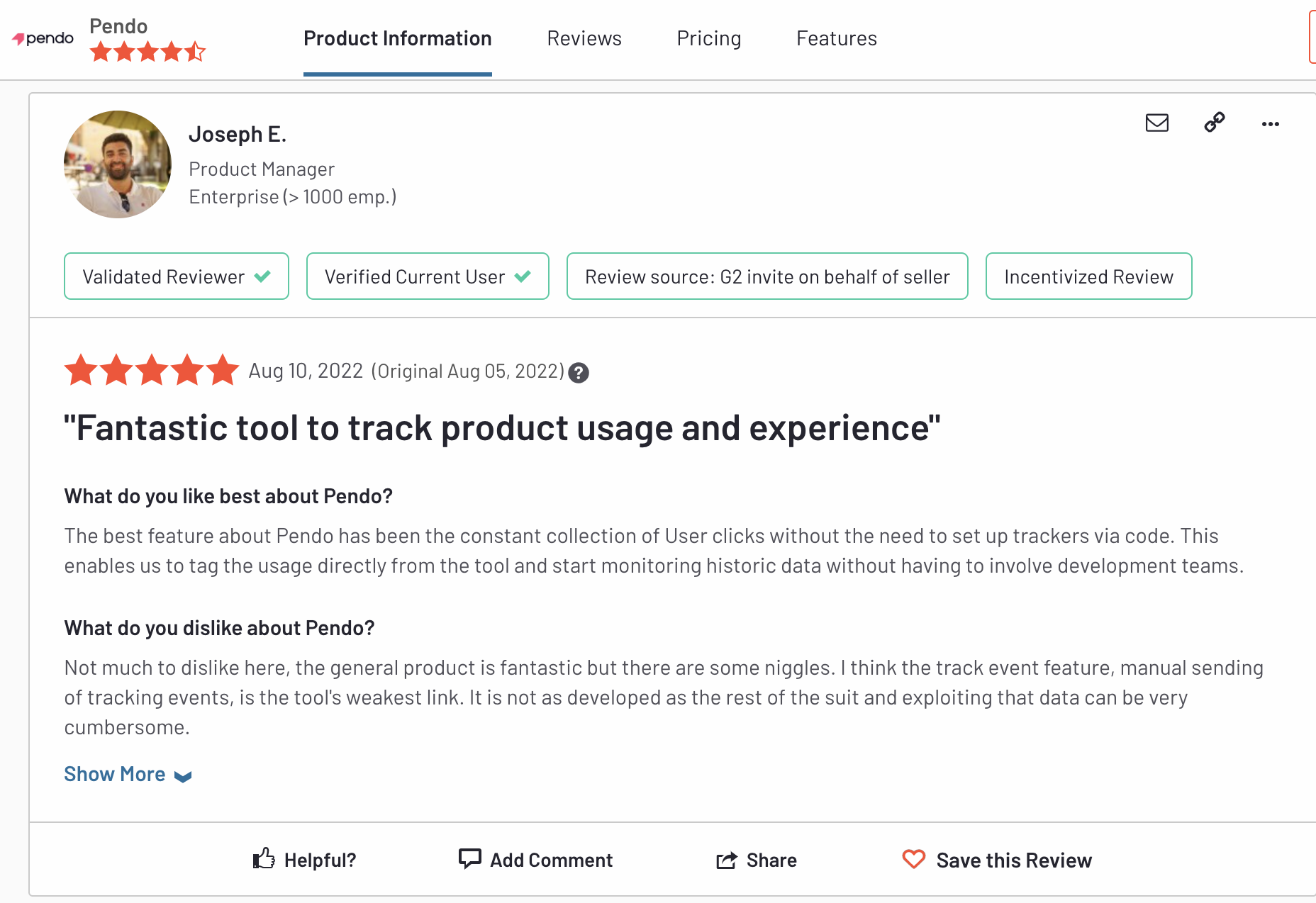
Most users complain about the lack of granularity in analyzing data and the price.
Not much to dislike here, the general product is fantastic but there are some niggles. I think the track event feature, manual sending of tracking events, is the tool’s weakest link. It is not as developed as the rest of the suit and exploiting that data can be very cumbersome.- Joseph E.
And there’s more:
While reports are thorough, a little more granularity would be welcomed. I don’t like that Feedback is a separate cost, as it is a very powerful tool to find out what users want to see in future releases.- Rob S.
And there’s more:
Need to be able to drill more into the Dashboard widgets. For example, using the Stickiness Metrics widget of WAU vs MAU is valuable but I should be able to click into these widgets to figure out which specific Clients these are referring to by different segments. This would be helpful information to hand over to other teams like Customer Success. It would also be helpful to be able to see which Clients are not using certain features when using the Behavior section to create reports. For example, if a CSM has 30 accounts and we can see that 14 are using a specific feature, having a quick list of the 16 not using the fea -Computer Software Admin.
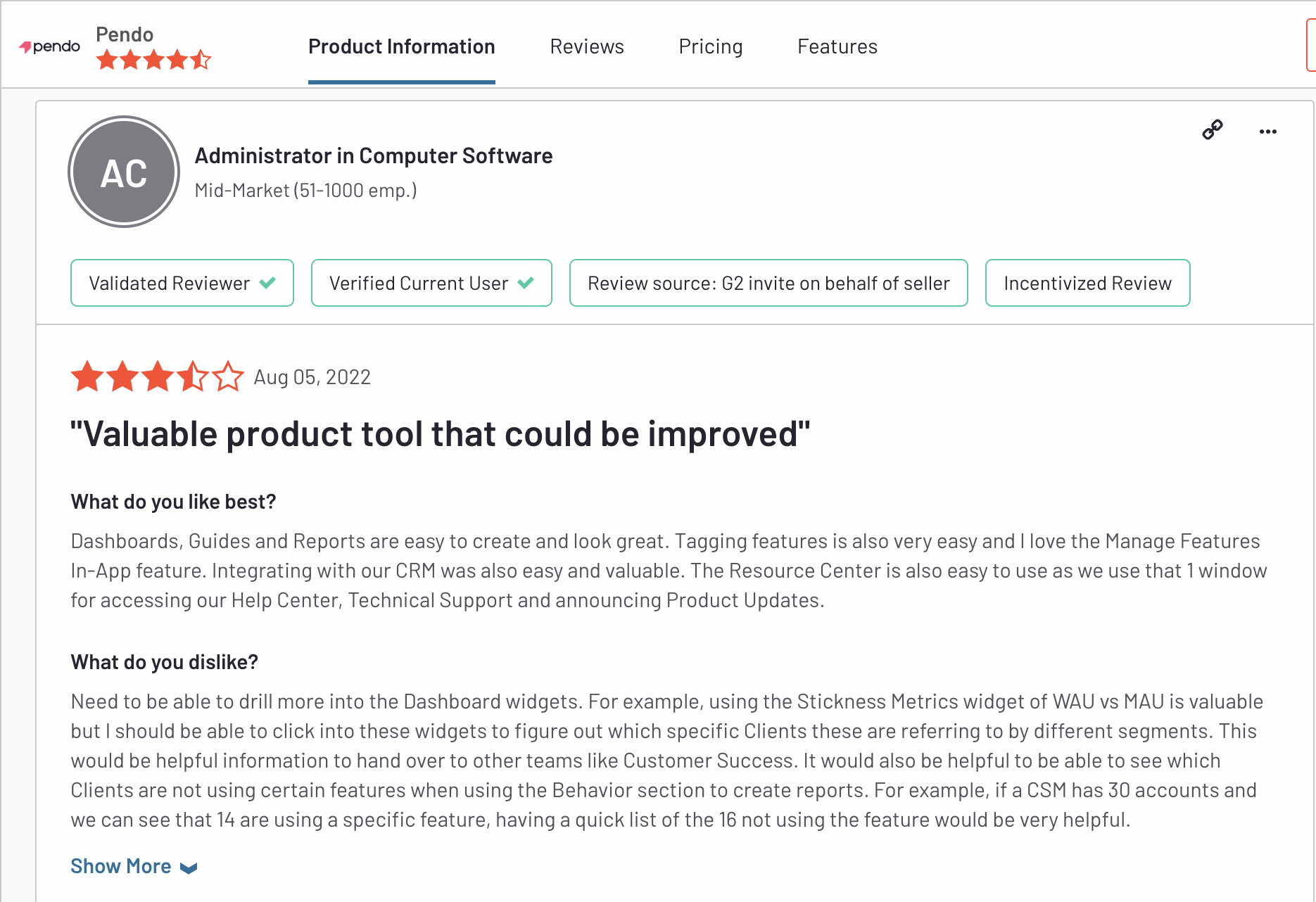
Is Pendo the right fit for your business?
Pendo shines when it comes to analytics, but that’s kind of its main superpower. Here are the top three reasons why you should be looking for an alternative.
- If you only need analytics, there are more affordable tools out there with better functionality too.
- If you want to build more than simple in-app guides and trigger them contextually, Pendo is not the best tool due to its basic guides functionality.
- Not convinced? The price in itself should be the main reason why Pendo is not the best solution.
Pendo pricing
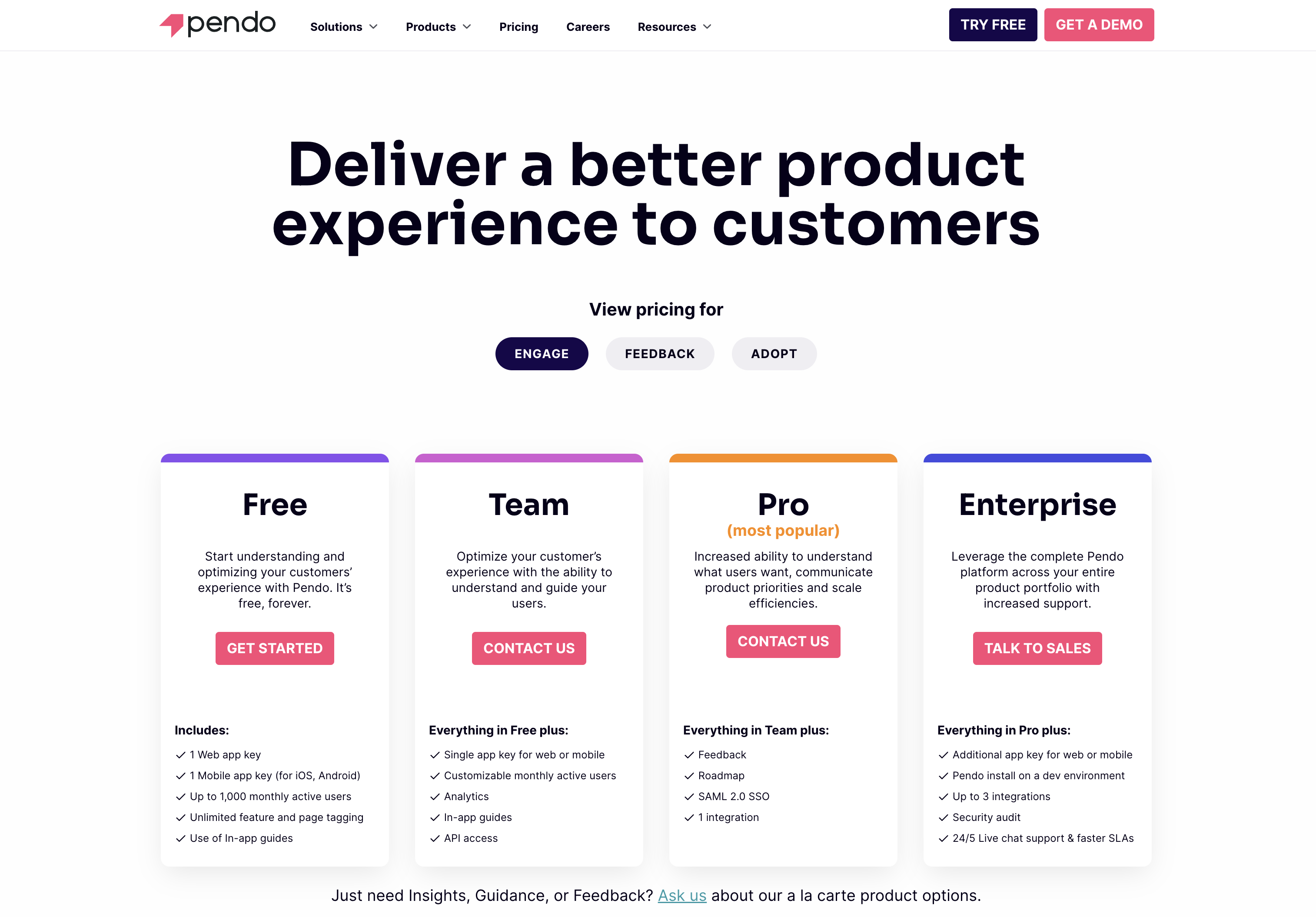
Pendo’s pricing is only available to you if you ask for a quote. The company doesn’t list pricing on its site for the higher tiers. However, some reviews say they have prices starting at $20,000-$25,000 per year for a single product, and around $50,000 per year for the mid-tier package.
The tricky part when it comes to Pendo’s pricing is that you get to pay separately for different modules:
- Pendo Free: up to 500 MAU, single-app, and basic functionality and analytics.
- Pendo Starter $7000/year: 2,000 MAU limit, multi-app, and access to premium features like NPS but it doesn’t include advanced analytics or integrations
- Pendo Growth: Custom MAU, single-app, NPS and PES, resource center, and access to support compared to lower plans
- Pendo Portfolio: Custom MAU, multi-app, cross-journey reports, experimentation, and 1 free integration included.
- Pendo Premium: Custom MAU, multi-app, everything in other plans plus custom roles and permissions and advanced security
- Pendo Feedback: collecting feature requests is a separate module with custom pricing.
- Pendo Adopt: employee onboarding is a separate module with custom pricing
![]()
There is a better tool for your SaaS than Pendo!

Walkme for new client onboarding
WalkMe is one of the pioneers in the market of adoption tools. It is a cloud-based software that allows you to create product tours and in-app experiences to drive adoption faster.
WalkMe is best for enterprise companies as they are focused on employee onboarding rather than user onboarding.
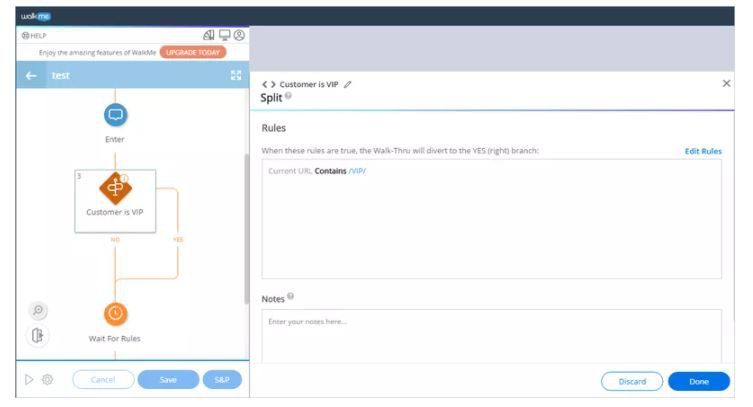
WalkMe user onboarding solution consists of 3 main guiding elements: WalkThrus, SmartTips, and ShoutOuts. These allow you to provide interactive in-app guidance to your customers.
Let’s have a quick look at each of these functionalities and how they help with user onboarding:
- WalkMe’s WalkThrus are its primary engine for creating user onboarding experiences. They overlay the target software or web app and provide on-screen guidance to help users complete tasks. In most cases, this means step-by-step instructions and tips that lead users from a starting point to the completion of a given task.
- SmartTips are also a form of on-screen guidance, but they’re less about the process and more about resolving points of friction. For example, with a SmartTip you can trigger a small note to pop up suggesting relevant links or giving more information about how to complete a form.
- ShoutOuts operate like SmartTips, but are geared toward in-product messaging. You can trigger them to pop up and give more information about relevant features, new updates, or product promotions.
- WalkMe also offers a couple of other more niche features for onboarding. For example Launchers (buttons that launch other WalkMe features or experiences), surveys, and an ActionBot (automated robo-chat to help users resolve issues and answer questions).
Pros of Walkme
WalkMe has its fair share of advantages that make it a solid tool. So what are WalkMe’s pros?
Here are our top three:
- Offers a high level of customization and works on both your own tool and 3rd party tools.
- Allows you to create in-app quizzes to test user or employee knowledge after completing a flow.
- Get access to a vast list of integrations that simply enhance your data collection or allow you to connect multiple tools in your stack.
Cons of Walkme
WalkMe is an established tool on the market but it does have its own share of cons too.
Here are the main ones you should consider:
- There’s a steep learning curve and a fair amount of technical knowledge required to create WalkMe user guides and get them implemented the way they’re intended.
- WalkMe is designed for enterprise organizations, and its pricing reflects that.
- You could end up spending anything from $9000 to $50000 a year on WalkMe. That’s a lot of money for startups and SMEs.
What users say about Walkme?
Users are mostly happy with WalkMe’s features: on-screen guidance, interactive walkthroughs, customizable UI patterns, and journey segmentation are highly used and appreciated by customers.
Here are some reviews from real users.
“The most valuable thing WalkMe provides is time. WalkMe provides the user with on-screen guidance to get them to where they need to be without weighing down support teams on training for every function. The automated steps can remove multiple clicks and quickly send the user to what they need to see. The ability to view user activity and search terms allows mapping new build requirements properly.”
“WalkMe is very user-friendly and easy to learn! There are so many different features of WalkMe to provide a customizable and creative experience for all of our users. I love creating smart walkthroughs and building flows charts, which is the most fun part of my day-to-day tasks!”
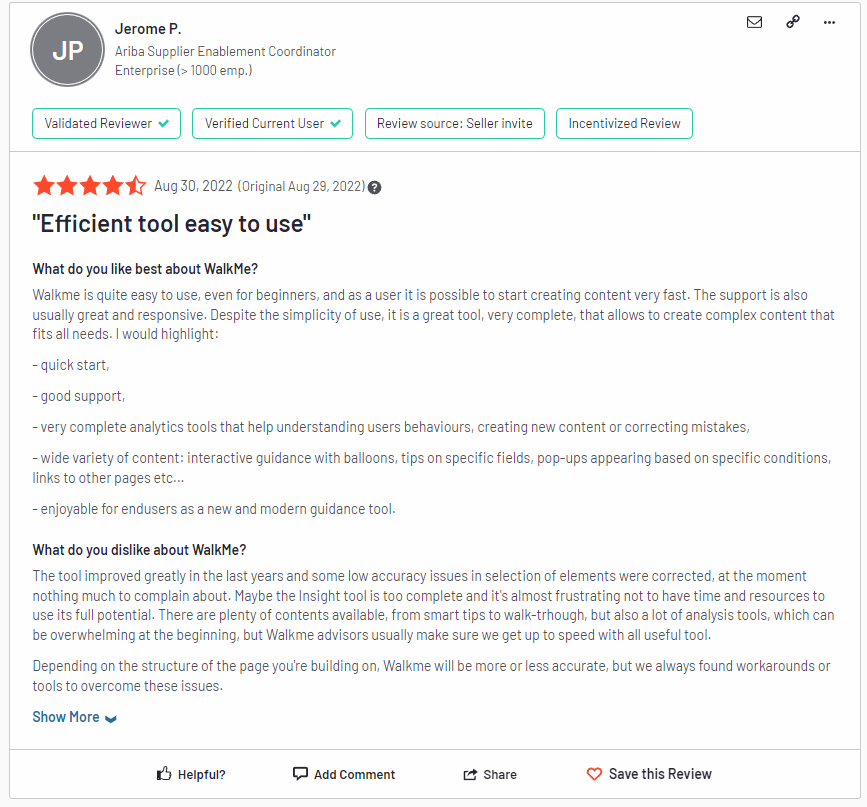
But Walkme is not a perfect solution, most complaints are about hard implementation and annual contract pricing.
Here are some words from real Walkme users:
We never had time to implement the product. It takes a huge time investment and isn’t designed for the full documentation. Rather than maintain two sets of documentation, we removed Walkme from our product. This company is as bad as AOL or TimeWarner: they will not let you out of your multi-year contract no matter how unhappy you are with the product.
The tool is not very intuitive and has countless challenges using and technical difficulties.
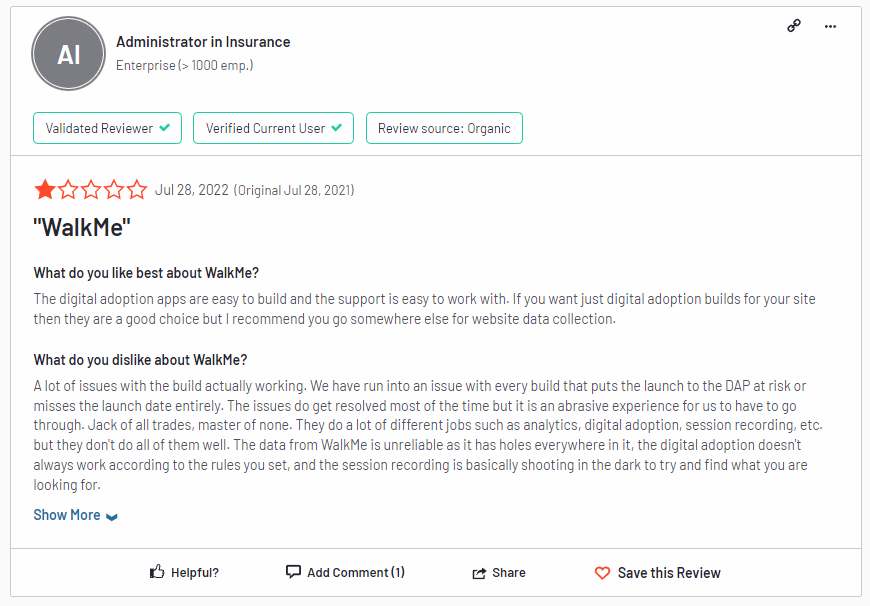
Is Walkme the right fit for your business?
Is WalkMe all you need or are there better alternatives that can provide more value at a much lower price? Here are the main reasons you should look for an alternative:
- WalkMe offers only yearly pricing contracts which start at $9000 so if you want to onboard new customers or provide in-app guidance then there are better solutions that won’t lock you in.
- WalkMe is known for its hard implementation so it’s not recommended for non-technical people. Generally, it can take weeks or even months. For better comparison, Userpilot can be set up in just a few minutes as it’s completely code-free.
- Bad and outdated UX design is another thing that might disappoint you and make you search for alternatives.
Walkme pricing
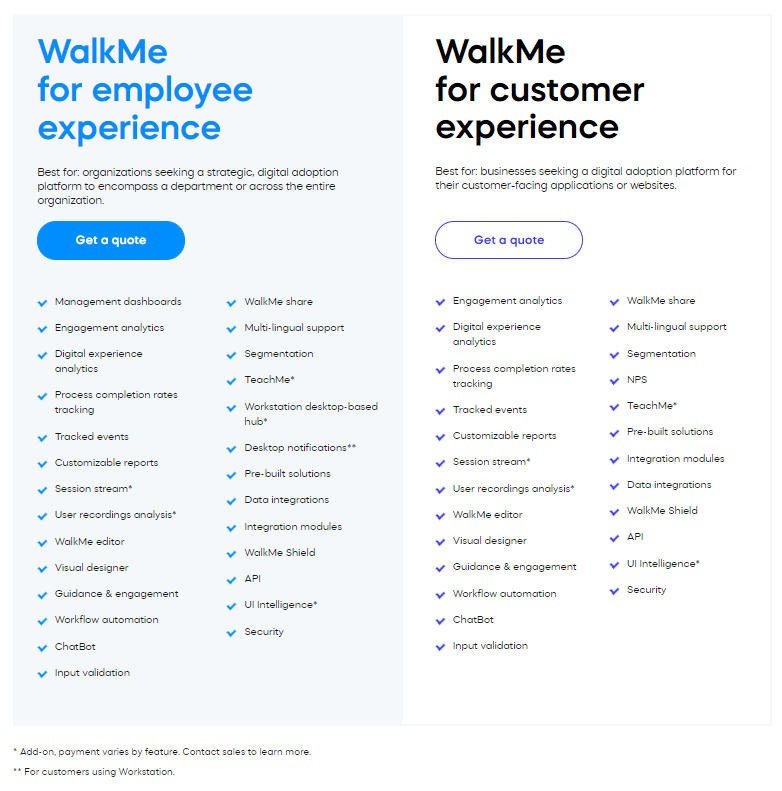
WalkMe works on a custom pricing plan that requires you to request a quote from their sales team (could be spending from $9000 to $50000 a year).
Their main two plans are:
- WalkMe for employee onboarding experience: engagement tools and analytics
- WalkMe for customer experience: engagement tools and analytics
- Add-ons: Session Streams, TeachMe, AI analytics through UI intelligence
![]()
There is a better tool for your SaaS than Walkme!

Is there a better alternative for new client onboarding?
Pendo and Walkme are good tools for new client onboarding. We’ve seen how they compare to each other and what you can achieve with them. Call us biased, but if you’re looking for something better, Userpilot offers more value for your money than these tools.
Userpilot for new client onboarding
Userpilot is a powerful product adoption platform that enables you to quickly build personalized, flexible, contextually relevant in-app experiences targeted to different user segments – all without writing a line of code.
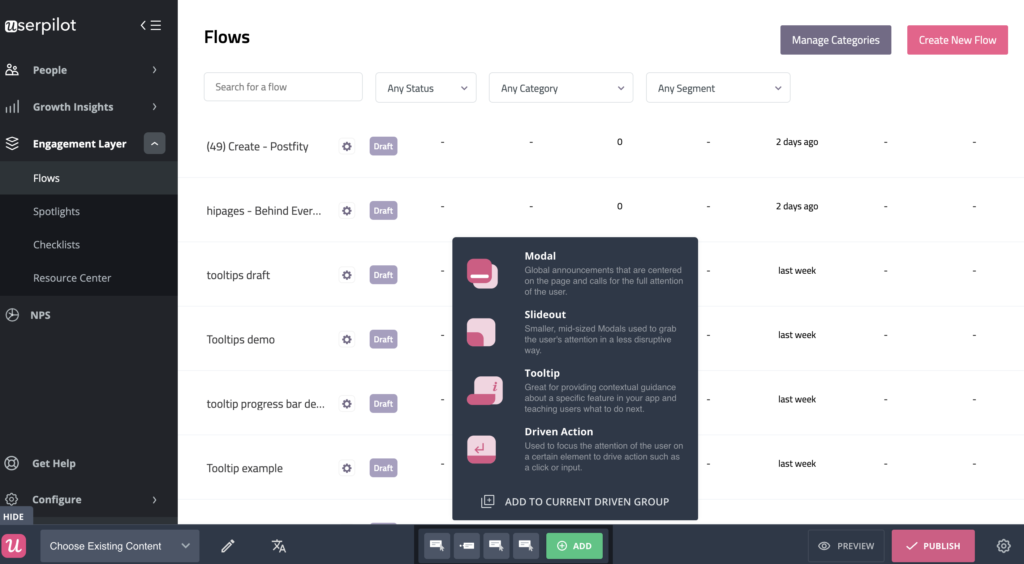
Userpilot was built specifically for SaaS product teams that want to improve their user onboarding experience and boost user activation.
You can build a huge variety of user onboarding experiences and in-app guidance flows without needing to code.
Here’s what you’ll get when you start using Userpilot:
- Forget about coding in-app experiences: Userpilot is a no-code solution and only requires your dev to install a line of javascript inside your app and for you to download a chrome extension that opens up the visual builder.
- Build in-app flows using the largest range of UI patterns (modals, slideouts, tooltips, hotspots, banners) and in-app onboarding experiences (checklists, microsurveys, NPS surveys, in-app resource center)
- Get access to a built-in NPS tool for collecting and analyzing user sentiment so you can improve your onboarding process based on real data.
- Create and track combinations of in-app events like clicks, hovers and form fills, and then analyze all these interactions under your own custom events, which can be built without code or API calls.
- Use advanced product analytics and in-app flows analytics to identify where users need help and create granular user segments to trigger in-app experiences contextually (segment based on user identification data, in-app engagement, custom events, clicks, hovers, form fills, user feedback responses, NPS scores and more)
- Enhance the onboarding experience with in-app help by launching a Resource Center directly inside your app. Add in-app guides, and video tutorials, and give users access to search the knowledge base or reach out to support. Self-service has never been easier.
The best user onboarding is contextual and it happens right where the users need it, inside your app. There isn’t a better user onboarding tool out there that offers more value for the money than Userpilot.
Schedule a demo with our team and get ready to build the best onboarding experiences your users have seen.
Pros of Userpilot
Userpilot has a number of advantages, especially for mid-market SaaS companies looking for a robust but at the same time very easy-to-use, a no-code tool for user onboarding, product adoption, and simplified product analytics. Let’s have a look at the pros of using Userpilot:
- No-code builder – Userpilot comes with an easy-to-use Chrome Extension builder.
- Multiple UI patterns – choose from a range of options to build customized flows: modals,
- slideouts, banners, tooltips, hotspots, and checklists are all at your disposal.
- UI patterns are not limited by plan – you get access to all of them on every single plan, meaning you get value even with the Traction plan (this is the entry-level one).
- Engaging walkthroughs and onboarding flows- build interactive walkthroughs targeted to distinct user segments.
- In-app help – build a resource center offering self-service support to your users, customize it with your branding, and select from a range of help options to boost user satisfaction (i.e. videos, in-app flows, chat, and more).
- Experimentation – built-in A/B testing for flows lets you explore and quickly iterate based on direct user behavior.
- Powerful feedback options- integrated NPS surveys with analytics and response tagging unlock insight into how your users feel.
- Advanced analytics and segmentation- analyze product usage and in-app flow engagement and build user segments using the data.
- Event tracking and feature tags- tag UI engagement (clicks, form fills, hovers) and group them into one custom event to track what really matters.
- More value with integrations- unlock value faster with built-in integrations with popular tools like Segment, Amplitude, Mixpanel, Kissmetrics, Intercom, Heap, and more.
Cons of Userpilot
Userpilot has a number of advantages, especially for mid-market SaaS companies looking for a robust but at the same time very easy-to-use, a no-code tool for user onboarding, product adoption, and simplified product analytics. Let’s have a look at the pros of using Userpilot:
- No-code builder – Userpilot comes with an easy-to-use Chrome Extension builder.
- Multiple UI patterns – choose from a range of options to build customized flows: modals,
- slideouts, banners, tooltips, hotspots, and checklists are all at your disposal.
- UI patterns are not limited by plan – you get access to all of them on every single plan, meaning you get value even with the Traction plan (this is the entry-level one).
- Engaging walkthroughs and onboarding flows- build interactive walkthroughs targeted to distinct user segments.
- In-app help – build a resource center offering self-service support to your users, customize it with your branding, and select from a range of help options to boost user satisfaction (i.e. videos, in-app flows, chat, and more).
- Experimentation – built-in A/B testing for flows lets you explore and quickly iterate based on direct user behavior.
- Powerful feedback options- integrated NPS surveys with analytics and response tagging unlock insight into how your users feel.
- Advanced analytics and segmentation- analyze product usage and in-app flow engagement and build user segments using the data.
- Event tracking and feature tags- tag UI engagement (clicks, form fills, hovers) and group them into one custom event to track what really matters.
- More value with integrations- unlock value faster with built-in integrations with popular tools like Segment, Amplitude, Mixpanel, Kissmetrics, Intercom, Heap, and more.
What users say about Userpilot

Let’s check what real users like about Userpilot.
Userpilot is an incredible, user-friendly software that allows us to create unforgettable experiences for our clients! From basic to complex experiences, we have been able to do them all with ease! I would highly recommend this software to anyone who wants to provide their clients or users with the best product tour experience. The possibilities of what you can create are endless! – Tayla G.
Userpilot is simple to set up, use, and does not require any dev – which means instant publishing. This is critical for us as a SaaS company that releases new features frequently; we need the ability to inform our customers of changes quickly, and doing this in our platform through Userpilot allows us to reach the right audience, at the right time, in the right place. There have been many awesome extra features we’ve discovered since coming on board, and it’s been great to see new features released frequently. The tool itself is intuitive and reliable. Having used similar products previously that were clunky and buggy this has really made us happy with our decision to move to Userpilot. – Melina K.
![]()
Get more value for your money with Userpilot!

Userpilot pricing
Userpilot’s transparent pricing ranges from $249/month on the entry-level end to an Enterprise tier for larger companies.
Furthermore, Userpilot’s entry-level plan includes access to all UI patterns and should include everything that most mid-market SaaS businesses need to get started.

Userpilot has three paid plans to choose from:
- Starter: The entry-level Starter plan starts at $249/month and includes features like segmentation, product analytics, reporting, user engagement, NPS feedback, and customization.
- Growth: The Growth plan starts at $749/month and includes features like resource centers, advanced event-based triggers, unlimited feature tagging, AI-powered content localization, EU hosting options, and a dedicated customer success manager.
- Enterprise: The Enterprise plan uses custom pricing and includes all the features from Starter + Growth plus custom roles/permissions, access to premium integrations, priority support, custom contract, SLA, SAML SSO, activity logs, security audit, and compliance (SOC 2/GDPR).
Conclusion
That’s it. Now it should be easier now to make an informed decision between Pendo and Walkme.
Both tools come with advantages and disadvantages so there isn’t one that is the best. It will depend on your product and current needs.
If you want the best value for money, try considering an alternative option.
Want to see how Userpilot can help with new client onboarding? Book a demo below.
![]()
There is a better tool for your SaaS than Pendo!


